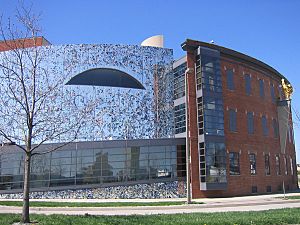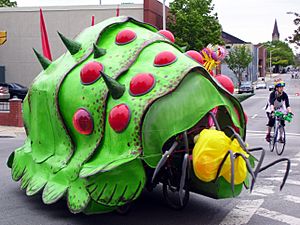American Visionary Art Museum facts for kids
 |
|
 |
|
| Established | November 24, 1995 |
|---|---|
| Location | Baltimore, Maryland, US |
| Type | Art museum |
| Visitors | Over 100,000 annually |
The American Visionary Art Museum (AVAM) is a special art museum in Baltimore, Maryland. It's located in the Federal Hill area. This museum focuses on collecting and showing "outsider art." This type of art is also called "intuitive art" or "raw art." It's made by people who haven't had formal art training.
The city of Baltimore gave the museum land near the Inner Harbor. But there was a condition: the museum had to clean up pollution from old factories there. The United States Congress has even called AVAM America's national museum for visionary art.
AVAM's campus is about 1.1 acres big. It has 67,000 square feet for showing art. The museum's permanent collection has around 4,000 pieces. These include works by artists like Ho Baron, Nek Chand, and Howard Finster. It also has over 40 pieces from the Cabaret Mechanical Theatre in London. AVAM proudly says its artists are "farmers, housewives, mechanics, the disabled, the homeless." They are all inspired by their inner creativity. The main building has three floors of art. The campus also has a Tall Sculpture Barn, a Wildflower Garden, and large spaces in the Jim Rouse Visionary Center.
The museum doesn't have its own staff curators. Instead, it invites guest curators for its shows. AVAM doesn't focus on just one artist or style. It creates themed exhibitions with fun names like Wind in Your Hair and High on Life. The museum's founder, Rebecca Alban Hoffberger, likes that AVAM is "pretty un-museumy." This means it's different from typical museums.
Contents
Discovering AVAM's History
The founder and director of AVAM is Rebecca Alban Hoffberger. She first thought of a visionary museum while working at Sinai Hospital in Baltimore. She was helping psychiatric patients return to their communities. Hoffberger was very impressed by the imagination of the patients' artwork. She wanted to focus on their strengths, not their illnesses.
Hoffberger found more inspiration when she visited the Collection de l'art brut in Switzerland. This museum was started by French artist Jean Dubuffet. He collected "l'art brut," which means "raw art." He called it raw because of the strong emotions in it. Hoffberger thought it was the "best, most imaginative, most original museum." She then decided to create her own visionary museum based on this idea.
In 1987, Hoffberger and curator George Ciscle held an art show. There, she officially announced her plans for AVAM. Her husband at the time, LeRoy Hoffberger, helped fund the museum. He sold some of his own art to raise money. With help from friends and family, Hoffberger asked the city of Baltimore for support. The city gave her two buildings near the Inner Harbor. The State of Maryland also provided money for construction. Hoffberger also raised $7 million from donors over six years. The museum was designed by architects Rebecca Swanston and Alex Castro. It officially opened on November 24, 1995. Visionary artists Gerald Hawkes and Vollis Simpson were the first visitors.
In 1999, AVAM started hosting the Kinetic Sculpture Race on the East Coast. This became an annual event. In 2004, the museum opened its third building, the Jim Rouse Visionary Center. This building used to be a whiskey warehouse. It now holds kinetic sculptures from the race. It also features Baltimore painted screens and other unique art. The center has classrooms and a large room for events.
In 2005, AVAM began its popular "Flicks from the Hill" series. This is a free outdoor movie series each summer. The movies are inspired by the museum's current art theme. Films are shown on a big screen below artist Adam Kurtzman's "Giant Golden Hand." The natural hillside can seat over 1000 people for these movies.
The museum also has a summer arts camp and an after-school program. These started in 2009. AVAM is also a popular place for weddings.
AVAM's Inspiring Mission
Rebecca Hoffberger believes a good museum does more than just show objects. She says great museums connect people to inspiration. AVAM's goals for education are also unique. They aim to:
- Help people see what makes a life worthwhile.
- Encourage respect for the talents of others.
- Show the many choices available in life, especially for students.
- Help everyone build on their own special knowledge and strengths.
- Promote using natural intelligence, intuition, and self-discovery.
- Confirm the desire to find what each person can do best.
- Empower individuals to do that something really well.
These goals were also adopted by The Lower East Side Girls Club when it started in 1996.
Community Connections
AVAM has a long history of helping its community. In 1997, some of AVAM's first full-time employees were hired from local homeless shelters. The colorful murals on the museum's outside walls were made by young people. They were part of AVAM's mosaic apprenticeship program in 2000. This program helped youth who were at risk or in detention.
AVAM also supports Baltimore art events. These include art car events and the yearly East Coast Championship Kinetic Sculpture Race. In 2010, AVAM started an After School program with Federal Hill Preparatory School. This gave students access to the museum's art and workshops. In 2012, some art made by these students was sold to help the Children's Home in Catonsville. AVAM also expanded its free workshops. They are now called The Institute for Visionary Explorers and are held at the Enoch Pratt Free Library. AVAM was also the site for the first Steps for the Cure, an event to raise awareness and money for breast cancer.
Past Exhibitions at AVAM
As of 2015, AVAM has hosted 20 annual "mega-exhibitions." Each show takes a big, inspiring theme that has interested people for a long time. This fits with the museum's "Sure-Fire Recipe for Enchantment."
Main Thematic Exhibitions
- Tree of Life • November 1995 – May 1996
- Wind in My Hair • May 1996 – May 1997
- The End is Near! • May 1997 – May 1998
- Love: Error and Eros • May 16, 1998 – May 30, 1999
- We are Not Alone - Angels and Other Aliens • October 2, 1999 – September 3, 2000
- Treasures of the Soul: Who is Rich? • October 7, 2000 – September 2, 2001
- The Art of War and Peace—October 6, 2001 – September 1, 2002
- High on Life • October 5, 2002 – September 1, 2003
- Golden Blessings of Old Age & Out of the Mouths of Babes • October 4, 2003 – September 5, 2004
- HolyH20: Fluid Universe • October 2, 2004 – September 4, 2005
- Race, Class, Gender ≠ Character • October 1, 2005 – September 3, 2006
- Home & Beast • October 7, 2006 – September 2, 2007
- All Faiths Beautiful • October 6, 2007 – August 31, 2008
- The Marriage of Art, Science and Philosophy • October 4, 2008 – September 6, 2009
- Life, Liberty & the Pursuit of Happiness • October 3, 2009 – September 5, 2010
- What Makes Us Smile? • October 9, 2010 – September 4, 2011
- All Things Round: Galaxies, Eyeballs & Karma • October 7, 2011 – September 2, 2012
- The Art of Storytelling: Lies, Enchantment, Humor, and Truth • October 6, 2012 – September 1, 2013
- Human, Soul & Machine: The Coming Singularity! • October 5, 2013 – August 31, 2014
- The Visionary Experience: Saint Francis to Finster • October 4, 2014 – August 30, 2015
- The Big Hope Show • October 3, 2015 – September 4, 2016
Single Gallery and Special Exhibitions
- Out of this World: Centennial Celebration of Eugene Von Bruenchenhein • March 2, 2010 – March 2, 2012
- Gretchen Feldman: Love Letter To Earth (1934-2008) • April 2012 – June 2013
- A Very Visionary Star-Spangled Sidewalk • Ongoing, opened Summer 2013
- Frank Bruno: A Life Devoted to The End. • July 9, 2013 – February 2, 2014
- Donald Pass: The Hope We Seek • February 28, 2014 – March 1, 2015
- Heaven's Carousel by Tim Otto Roth – Celebrating The Hubble Space Telescope's 25th Anniversary (outdoors) • April 24, 2015 – May 2, 2015
- Mr. Eddy Lives! • April 11, 2015 – April 2016


